8 Types of Ticks in Oklahoma (With Pictures)
-
Lindsey Lawson
- Last updated:

Ticks are among the most hated parasites along with the dreaded mosquito. That’s because these tiny arachnids carry a wide variety of diseases, including some zoonotic diseases that can be transmitted from animals to humans.
Whether it’s wildlife, livestock, domestic animals, or humans, you can bet these pests are always lurking by to find themselves unsuspecting hosts. In this article, we’ll talk about the types of ticks found in Oklahoma and give you information on the habits of each species. We’ll also touch base on some tips on how to best avoid these unwelcome parasites.
The 8 Types of Ticks in Oklahoma
1. Black-legged Tick
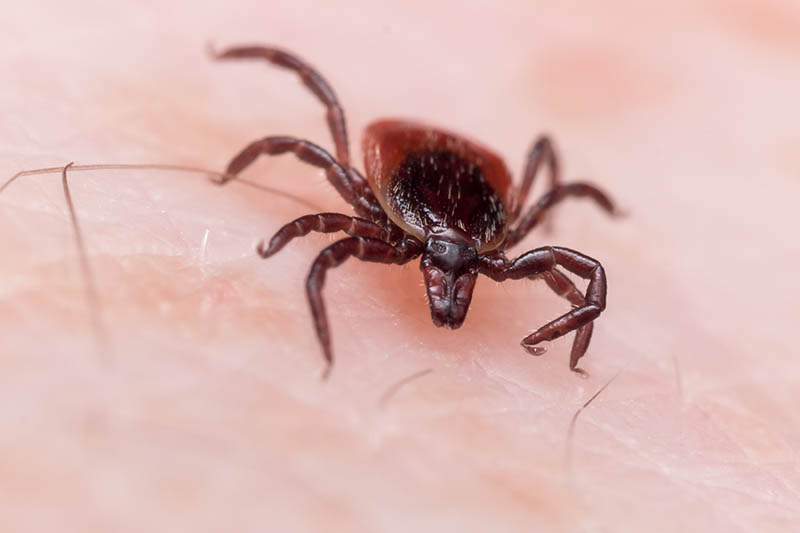
| Species: | Ixodes scapularis |
| Longevity: | Up to 2 years |
| Adult size: | 3 mm |
The black-legged tick is common throughout the eastern half of the United States in deciduous forest regions and within tall grasslands and shrubs that border the forest edge. Their primary hosts are whitetail deer, which is widely responsible for the distribution of this species.
Also known as the deer tick, the species is common to both livestock and wildlife within Oklahoma. They are a three-host tick that is most active from late September through April. When in the larvae and nymph stages, these ticks will feed on small animals like snakes and lizards rather than small rodents like other species.
They are known for transmitting Lyme disease and many other pathogens like Anaplasmosis, Babesiosis, and Powassan Virus.
2. Winter Tick
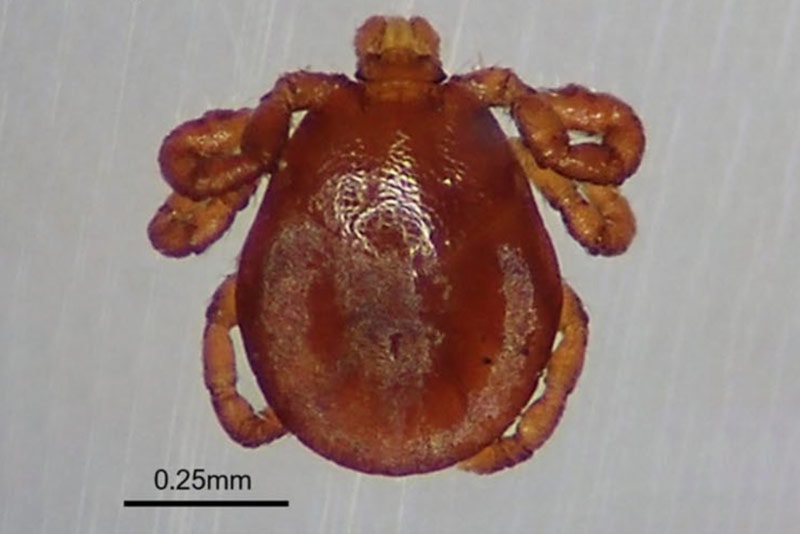
| Species: | Dermacentor albipictus |
| Longevity: | 1 year |
| Adult size: | Up to ¼ inch |
The winter tick is the only single-host hard tick within the state of Oklahoma. They are a common pest to larger animals like horses, cattle, deer, and elk within the state and are known for transmitting anaplasmosis in cattle. Large animals with heavy infestations can fall victim to potentially fatal blood loss if they remain untreated.
Larvae become active during the fall, primarily in early October. Nymph and adult seasons peak during the late fall and remain active through winter and early spring, which is how they get their name. Winter ticks are not known to carry diseases transmissible to humans and rarely ever feed on humans anyway.
Outside of Oklahoma, this species is best known for heavily infesting moose. They only ever leave the host to lay eggs during the spring. The female will then die off, but the life cycle will begin again during the summer when the eggs hatch.
3. American Dog Tick

| Species: | Dermacentor variabilis |
| Longevity: | Up to 3 years |
| Adult size: | ¼ – ½ inches |
The American dog tick, which is sometimes referred to as the wood tick, is a common species that is found feeding on domesticated animals and a variety of wildlife. They are also no strangers to humans. This species is found throughout most of North America along forest edges and grassy fields.
Larvae and nymphs of these three host species typically stick to small rodents, it’s the adults that graduate to the larger animals and people. They are a large species that are known for transmitting a variety of diseases.
They have been linked to Rocky Mountain spotted fever, bovine anaplasmosis, feline cytauxzoonosis, canine monocytic ehrlichiosis, and human monocytic ehrlichiosis. They’ve also been recorded as causing tick paralysis in humans and dogs.
4. Brown Dog Tick
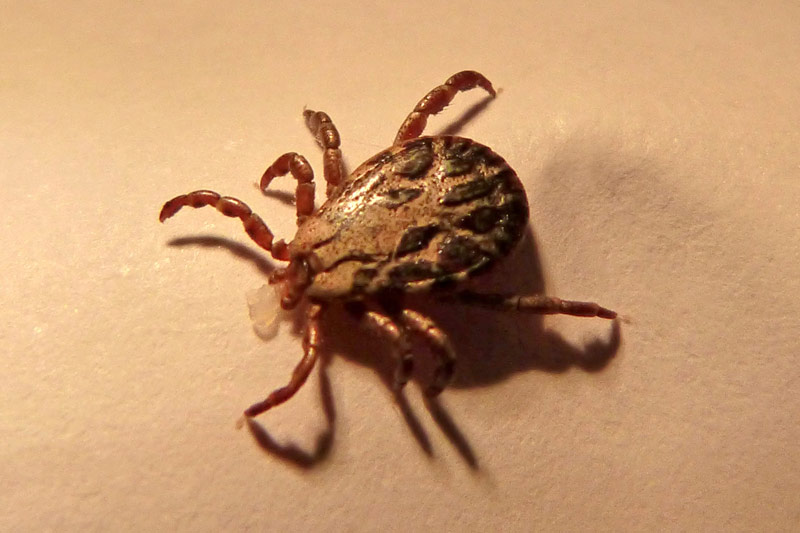
| Species: | Rhipicephalus sanguineus |
| Longevity: | Up to 3 years |
| Adult size: | 1/8 – ½ inches |
The brown dog tick is one of the most common ticks in the state of Oklahoma and is widely distributed throughout the entire world. They are a three-host tick and as the name suggests, dogs are their primary hosts, and they will spend all their life stages feeding on dogs.
These ticks are typically found tucked away between the toes or in the ears. The species prefers wooded or grassy areas and transmits several diseases including Rocky Mountain spotted fever, canine Ehrlichiosis, and canine Babesiosis.
In the absence of dogs, brown dog ticks have been known to feed on humans. They will also frequently inhabit human dwellings, especially those that house dogs. They can be found inside various structures and even in and around kennels.
5. Lone Star Tick

| Species: | Centruroides vittatus |
| Longevity: | Up to 2 years |
| Adult size: | 1-3 inches |
The Lone Star tick is a species that is common throughout the southeastern and eastern United States. It is connected to the transmission of many tick-borne diseases such as ehrlichiosis, Heartland virus disease, southern tick-associated rash illness, Bourbon virus disease, and tularemia.
Contrary to popular belief, this tick does not get its name after the state of Texas, but for the white spot found on the backs of the adult females, which makes them stand apart from other varieties. They are a three-host tick that will feed on a variety of livestock, wildlife, and humans.
In Oklahoma, people tend to notice these ticks when doing outdoor recreational activities. They are common along hiking trails but are also dense in wooded areas and places with lots of overgrown vegetation.
6. Gulf Coast Tick

| Species: | Amblyomma maculatum |
| Longevity: | Up to 3 years |
| Adult size: | Up to 6 mm |
Gulf Coast ticks are common in the southeastern United States along the Gulf of Mexico and the Atlantic coast. They are known for transmitting Rickettsia parkeri, which causes a spotted fever rickettsiosis in humans.
The number of Gulf Coast ticks has increased substantially in Oklahoma since the 1950s when they were introduced by previously infested cattle. The seasonal peak of this species depends on the region but in Oklahoma and Kansas, they are common from February through October.
This species is a three-host tick that is common to ground birds and rodents during their larvae and nymph phases. Adults will feed on a variety of prey including humans, dogs, cattle, horses, deer, coyotes, and much more.
7. Fowl Tick
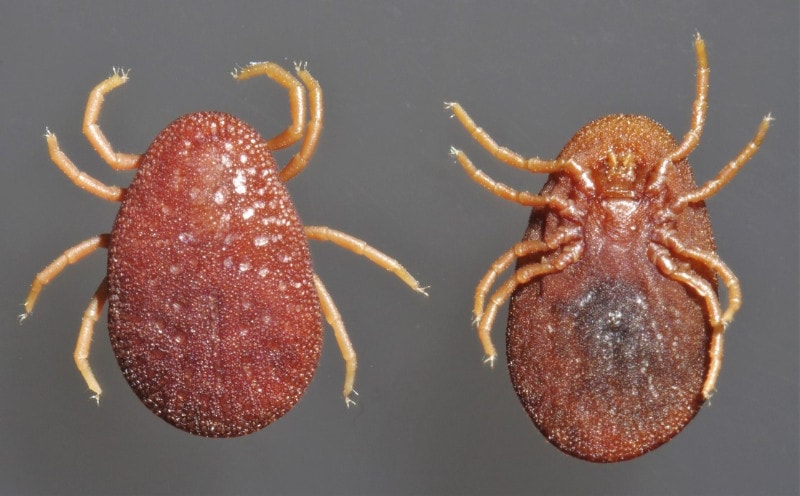
| Species: | Argas persicus |
| Longevity: | 4 + years |
| Adult size: | ¼ – 3/8 inches |
The fowl tick is a species of soft tick, which lacks the hard outer plate called the scutum. They are a common parasite among poultry and are also referred to as the “blue bug.” Adult fowl ticks primarily feed during the night and spend their days hiding in dens, burrows, and the cracks and crevices of human dwellings.
These ticks have wrinkled bodies and range in color from light to dark reddish brown. While they are most common in areas that house poultry, they can also infest home and feed on pets and people. They are distributed worldwide, but here in the United States, they are most common in the south and southwestern part of the country.
If poultry becomes infested with fowl ticks, it can lead to anemia, weight loss, depression, toxemia, decreased egg production, and even paralysis. Keepers may notice red spots on the skin of the bird where the ticks have fed. They thrive best in warm, dry conditions and unlike species of hard ticks, they have much longer lifespans of 4 years or more.
8. Spinose Ear Tick
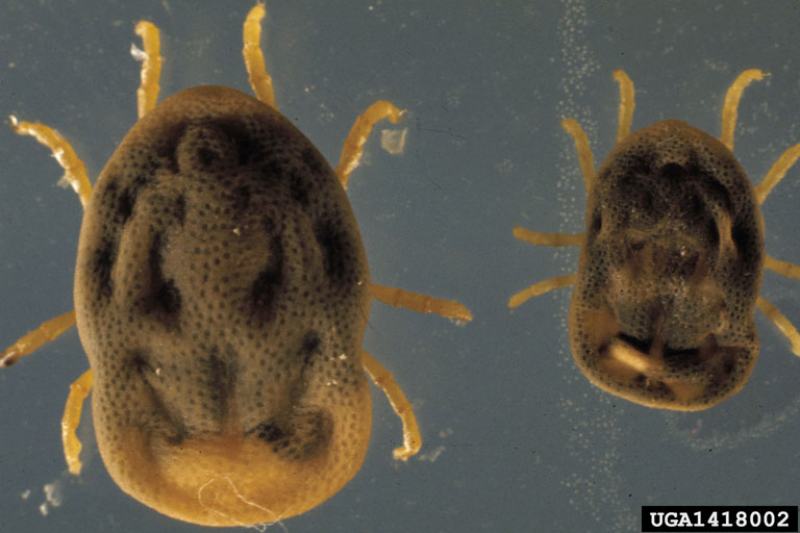
| Species: | Otobius megnini |
| Longevity: | 123 days |
| Adult size: | Up to 10 mm |
The Spinose ear tick is another soft tick species that is widely distributed throughout much of North America. They were first discovered in 1883 in northern Mexico and as their name implies, they like to burrow deep in the ear canal of their prey.
Unlike most species, the Spinose ear tick will spend its entire life feeding on a single host. The larvae and nymphs feed on blood but once they reach the molt into the adult stage, they become nonparasitic.
They are most common on horses, cattle, and other farm animals. They are also known to feed on wildlife and have even been caught feeding on humans. If an animal becomes infested with many of these ticks it can lead to severe inflammation and irritation of the area that could eventually lead to deafness if left untreated.
Tick-borne Diseases with Reports in Oklahoma
Ticks are well known for causing a wide variety of diseases. We’ve included a list of the diseases spread by these parasites that have a history of reports within the state of Oklahoma.
Preventing Ticks and Tick-Borne Disease in Pets and People
Ticks aren’t your typical pest since they bring the risk of disease transmission. Preventing diseases commonly transmitted by these parasites will involve preventing tick bites. Here are some tips on how to steer clear of ticks and prevent getting bitten.
Be Wary in Areas Where Ticks Are Common
Ticks are commonly found in grassy areas, within and on the edges of forests, and along hiking trails awaiting a host to pass by. If you are out hiking, try and stick to the trails as much as possible and avoid going off the path. Never go into areas with tall grass or lots of leaf litter unless you must. While these areas can’t always be avoided, it’s best to dress appropriately to make it difficult for ticks to get to your skin.
Check Your Body for Ticks When You Come Indoors
When you go indoors after being outside for any amount of time during the tick season, especially spring, summer, or fall make sure to examine your body to ensure no ticks are grabbed on. Make sure to check your head too, ticks will sometimes go undetected hidden beneath your hair. Feel down to your scalp and check every inch.
Tumble Dry Your Clothes

It’s sometimes recommended that you wear light clothing to make it easier to spot any ticks you’ve gathered while outdoors. Though some studies have shown that ticks may be drawn to light colors, especially the black-legged, or deer tick since the underbelly of their preferred host is white.
Regardless of what colors you choose, you can put your clothes in the dryer for about 20 minutes on a higher heat setting to kill the ticks. If your clothes need to be washed anyway, wash them in hot water then tumble dry.
Use Bug Repellent
One way to avoid ticks and other parasites is by using bug spray on any exposed areas of skin while you’re spending time outdoors. Ticks are typically repelled with products that contain 20 to 30 percent DEET. If you are looking to avoid DEET due to health concerns, there are some natural repellents, though they may not be as effective. This includes essential oils from lemon, orange, cinnamon, lavender, peppermint, and rose geranium.
Keep Your Pets Protected
You aren’t the only one that can easily fall victim to ticks, your pets are at risk, too. Keeping your domesticated animals up to date on flea and tick prevention medication is the best defense against these pesky, disease-carrying parasites.
Whenever your pets come in from outdoors, give them a very thorough inspection to ensure no ticks have latched on. They can be easy to miss, especially when they are smaller so pay attention to detail. Try using a fine-toothed comb to brush through their coat or even bathe them with flea and tick shampoo.
Treat Your Yard

There are a few things you can do to try and keep your yard tick-free. You can start by keeping up with regular lawn maintenance to stop the grass from becoming too high. Clear out weeds and rake leaves regularly to prevent these areas from inviting them in.
Keep any firewood stacked neatly in a safe, dry area, and keep any outdoor furniture or playground equipment away from trees or wooded areas of the yard. If you live near a heavily wooded area, create a barrier between your yard and the woods. This could be a fence or even gravel or wood chips.
Some homeowners choose to have their yards treated with pesticides each year to prevent pest infestations. If you choose to do this, make sure you tell the exterminator that you wish to repel ticks. Make sure you check into any regulations regarding the use of pesticides and do your research on the safety and environmental impacts of these chemicals.
Conclusion
There are six species of hard tick and two species of soft tick that aim to feed on various livestock, pets, wildlife, and humans in Oklahoma. This includes both single host species and three host species and each one has its own unique life cycle and habits. One thing they all have in common is that they are vectors of disease. While not all ticks transmit the same diseases, it’s best to do what you can to avoid falling victim to these nasty parasites and protect your pets and livestock at all costs.
- https://extension.okstate.edu/fact-sheets/common-ticks-of-oklahoma-and-tick-borne-diseases.html
- https://cwhl.vet.cornell.edu/disease/winter-tick
- https://www.cdc.gov/ticks/tickbornediseases/tickID.html
- https://www.merckvetmanual.com/poultry/ectoparasites/flies,-gnats,-and-mosquitoes-of-poultry
- https://www.mayoclinic.org/diseases-conditions/lyme-disease/symptoms-causes/syc-20374651
- https://www.cdc.gov/stari/index.html
- https://pubmed.ncbi.nlm.nih.gov/16051573/
- https://www.cdc.gov/lyme/index.html
- https://www.cdc.gov/ticks/tickbornediseases/rmsf.html
- https://www.cdc.gov/ticks/tickbornediseases/rmsf.html
- https://www.cdc.gov/ticks/tickbornediseases/rickettsiosis.html
- https://www.cdc.gov/ticks/tickbornediseases/heartland-virus.html
- https://www.cdc.gov/ticks/tickbornediseases/anaplasmosis.html
- https://www.cdc.gov/ticks/tickbornediseases/ehrlichiosis.html
- https://www.cdc.gov/ticks/tickbornediseases/tularemia.html
- https://www.cdc.gov/ticks/tickbornediseases/tick-bites-prevention.html
Featured Image Credit: Erik Karits, Pexels
Contents
